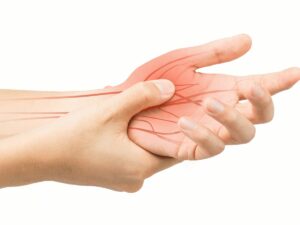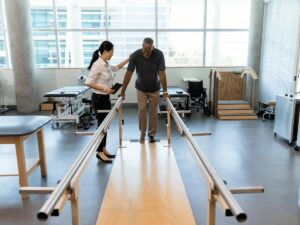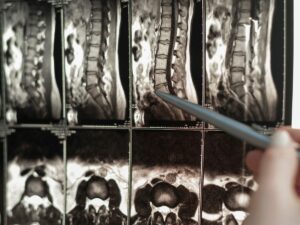Can HBOT help nerve damage? Absolutely, it offers promising results for enhancing recovery processes.
With years of expertise in hyperbaric medicine, I bring a wealth of knowledge and practical insights. Trust in my guidance to explore cutting-edge health solutions.
HBOT shows promising results in aiding nerve repair and regeneration. This therapy could redefine recovery processes for numerous conditions, offering new hope for enhanced healing.
In this guide, you’ll uncover how HBOT works, its benefits for nerve damage, and practical considerations for integrating it into health and wellness programs.
Discover healing possibilities!
1. The Science Behind HBOT and Nerve Repair
Hyperbaric Oxygen Therapy (HBOT) is gaining attention for nerve repair, notably because it significantly enhances oxygen concentration in the body’s tissues by breathing pure oxygen in a pressurized environment. This boost in oxygen is crucial for the healing process, particularly for damaged nerves that need a high oxygen supply for repair.
But wait, there’s more, HBOT not only increases oxygen supply but also stimulates biological processes beneficial for nerve repair, such as reducing inflammation and fostering new blood vessels. These actions support direct healing and create an optimal environment for nerve recovery.
Research from the National Library of Medicine shows the efficacy of HBOT in improving nerve recovery post-surgery, with a regimen of 1 session daily for 5 days significantly speeding up the healing process. This demonstrates HBOT’s role in enhancing post-surgical nerve repair.
2. Biological Mechanisms of HBOT in Nerve Repair
The biological mechanisms of Hyperbaric Oxygen Therapy in nerve repair are fascinating and multifaceted. Firstly, HBOT dramatically increases the amount of dissolved oxygen in the bloodstream, reaching tissues at a faster rate. This surge in oxygen availability is crucial for the metabolic processes of healing nerve cells, aiding in their recovery and regeneration.
And the best part is, HBOT not only facilitates a higher oxygen delivery to damaged nerves but also plays a significant role in modulating the body’s inflammation response. By reducing inflammation, it helps to clear the path for the regrowth of nerve fibers, while simultaneously encouraging the formation of new blood vessels. This dual action speeds up repair and ensures a stronger recovery of nerve functions.

3. Types of Nerve Damage Treated with HBOT
Following our exploration of how HBOT aids in nerve repair through enhancing oxygen delivery and reducing inflammation, it’s clear this therapy offers significant benefits. Here are the types of nerve damage treated with HBOT:
Diabetic Neuropathy
Many people with diabetes suffer from this condition, where high blood sugar levels damage nerves, particularly in the legs and feet. HBOT helps by improving oxygenation and circulation, aiding in nerve function restoration.

Traumatic Brain Injuries (TBI)
Injuries to the brain can also affect nerve function throughout the body. OxygenArk hyperbaric chamber has been shown to reduce swelling and facilitate the healing of brain tissue, which can improve neurological outcomes.

Peripheral Neuropathy
Caused by damage to the peripheral nerves, symptoms can include numbness and pain in the hands and feet. HBOT supports nerve regeneration and alleviates the pain and discomfort associated with this condition. Amazing, isn’t it?

Stroke Recovery
Strokes can lead to various forms of nerve damage due to interrupted blood flow to the brain. HBOT can enhance recovery by improving oxygen supply to the affected brain tissue, helping to revive damaged nerves.

Spinal Cord Injuries
Damage to the spinal cord can have a profound impact on nerve function. HBOT has been utilized to reduce inflammation and promote healing in the spinal cord, potentially restoring some functions lost to injury.

4. The HBOT Treatment Process for Nerve Damage
After exploring the various types of nerve damage that HBOT can treat, one might wonder about the treatment process itself. Here are the steps involved:
Step#1 Initial Consultation and Evaluation
Before starting HBOT, patients undergo a thorough evaluation to assess their specific condition and suitability for the therapy. This step ensures the treatment plan is customized to meet individual needs, optimizing outcomes.
Step#2 Session Planning
Based on the initial evaluation, a personalized treatment plan is developed. This plan outlines the number of sessions required and their frequency, which can vary depending on the severity of the nerve damage and the patient’s response to therapy.
Step#3 The Treatment Sessions
During an HBOT session, the patient enters a pressurized chamber where they breathe 100% oxygen. This process can last from 60 to 90 minutes, during which the increased pressure and oxygen levels work together to enhance the body’s natural healing processes.
Step#4 Monitoring and Adjusting the Treatment
Throughout the treatment, progress is closely monitored. So what’s my point? adjustments to the treatment plan may be made based on the patient’s response, ensuring the most effective course of action is always being taken.
Step#5 Post-Treatment Evaluation
After completing the series of HBOT sessions, a final evaluation is conducted to assess the outcomes and improvements. Follow-up care and additional sessions might be recommended based on the results and ongoing needs.
5. HBOT vs. Traditional Nerve Damage Treatments
Understanding the HBOT treatment process for nerve damage sets the stage for a deeper look into how it compares with traditional treatments. Here are the key differences between HBOT and traditional nerve damage treatments:
Speed of Recovery
HBOT accelerates the healing process by directly increasing oxygen levels in damaged nerve tissues, leading to quicker recovery times. Traditional methods may rely on medication or physical therapy, which often work slower and indirectly support healing.
Mechanism of Action
HBOT works by enhancing oxygen delivery to the injured nerves, stimulating healing at the cellular level. In contrast, conventional treatments often focus on symptom management rather than addressing the underlying cause of nerve damage.
Side Effects
The side effects associated with HBOT are relatively minimal and often temporary, such as ear pressure changes. Conversely, traditional treatments, especially those involving medication, can have a broader range of side effects, some of which may be more severe or long-lasting.
Cost of Treatment
The cost of traditional nerve damage treatments varies widely, but physical therapy sessions may range from $50 to $350 each, depending on location and specialist expertise. In comparison, HBOT requires an initial investment of $200 to $450 per session. While this may seem higher at first glance, HBOT can be more cost-effective in the long term by potentially reducing the need for prolonged therapy sessions.
Accessibility
Traditional treatments for nerve damage are widely accessible across various healthcare settings. HBOT, while becoming more available, is still more specialized and may not be as easily accessible in all areas, requiring patients to seek out specific centers that offer this type of therapy.
6. Challenges and Limitations of HBOT in Treating Nerve Damage
After exploring how HBOT compares with traditional nerve damage treatments, it’s clear that HBOT offers unique benefits. However, it’s not all smooth sailing, here are the challenges and limitations of HBOT in treating nerve damage:
Treatment Duration and Frequency
HBOT requires a commitment to multiple sessions, often spanning weeks to months, for effective nerve damage treatment. This time commitment can be demanding and logistically challenging for patients, especially those with busy schedules or limited mobility.
| Challenge |
Description |
| Time Commitment |
HBOT typically requires multiple sessions over weeks to months, necessitating a significant time commitment. |
| Logistics |
The logistical challenges of scheduling numerous sessions can be burdensome for patients with busy schedules. |
| Mobility Constraints |
Patients with limited mobility may face difficulties in accessing HBOT facilities regularly for treatment. |
| Financial Costs |
The cumulative costs of multiple HBOT sessions over an extended period can impose a significant financial burden. |
| Psychological Impact |
The prolonged duration of treatment can lead to psychological strain and fatigue for some patients. |
Limited Availability
HBOT facilities are not as widespread as traditional treatment centers, making access a challenge for some patients. Individuals may need to travel significant distances or face long waiting lists to receive therapy.
Patient Health and Safety Concerns
Although generally safe, HBOT is not suitable for everyone. Certain medical conditions, such as untreated pneumothorax or certain types of ear problems, can make undergoing HBOT risky, limiting its applicability.
Limited Research in Specific Areas
Although research supports HBOT’s effectiveness for certain types of nerve damage, studies in other areas remain limited. The lack of comprehensive data can make it difficult for healthcare providers to recommend HBOT universally for all nerve damage conditions.
7. 3 Practical Tips for Considering HBOT for Nerve Damage
To effectively navigate the challenges and limitations associated with HBOT for nerve damage, it’s important to have a clear strategy. Below, you’ll find comprehensive tips designed to guide individuals through the decision-making process regarding this treatment option:
#1 Consult with Specialists
Discuss HBOT with a healthcare provider knowledgeable about both HBOT and nerve damage. For instance, a neurologist or a rehabilitation specialist might provide insights into how HBOT can fit into the overall treatment plan.
#2 Research Qualified HBOT Centers
Start by finding accredited HBOT facilities with experience in treating nerve damage, such as those using equipment from reliable manufacturers like OxygenArk. For instance, look for centers that are part of reputable medical institutions or those with certifications in hyperbaric medicine, indicating they maintain high standards of care and safety.
#3 Look for Patient Testimonials and Case Studies
Hearing about others’ experiences with HBOT for nerve damage can provide valuable insights. For instance, patient testimonials or case studies highlighting recovery journeys may offer encouragement and a realistic perspective on what to expect.
Dive Deeper Into Our Resources
Looking for more diverse product options? Browse through our handpicked selections:
Still haven’t found what you’re looking for? Don’t hesitate to contact us. We’re available around the clock to assist you.
Conclusion
HBOT presents a promising avenue for nerve damage recovery, offering enhanced healing through increased oxygen delivery. This guide has outlined the therapy’s principles, showcasing its potential across various fields.
For businesses seeking deeper insights into Hyperbaric Chambers, Oxygen-Ark offers expert guidance and solutions. Feel free to contact us for more information.






